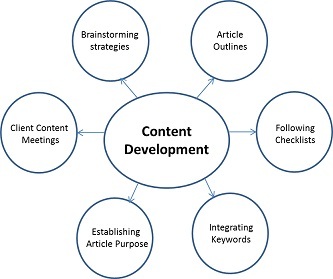
With a bird’s eye view, it may seem like the topics around a particular subject are endless. However, as you get closer to putting pen to paper, even the most experienced writer can struggle to come up with fresh, attention-getting ideas. Developing spider webs, or what is sometimes known as mind mapping, is one excellent approach to generate a fruitful supply of quality articles related to a given theme.
Understanding the Spider Web
A spider web approach to brainstorming begins with a primary theme or central topic. For instance, content development is a major topic in the broader marketing category of content marketing.
The evolution of the spider web takes place as you come up with article topics or titles tied to content development. Another way of looking at it is that the article topics are subtopics of your major topic.
Building the Article Spider Web
The first step in the spider web approach to brainstorming article topics is to place your theme in a circle in the middle of a paper or on a whiteboard.
Next, add several lines or branches from the center circle to smaller circles or boxes. If your goal is to generate eight fresh article ideas, create eight branches.
Article Spider Web Example
There is nothing magical about the structure or format for an article spider web for brainstorming article topics. What matters is the visual illustration that drives your creative juices.
Here is an example of a spider web of article ideas on “content development”:

Focusing on theme-based article topics can cause a snowball effect with ideas.
From Brainstorming to Title Creation
It isn’t necessary to firmly commit to writing an article on each idea. The point of brainstorming is to quickly get ideas from brain to paper. After you develop a list of topics, decide which ones to incorporate into your content schedule. Then, craft captivating and search-friendly article titles that drive purposeful writing.
Benefits of Visual Brainstorming
Brainstorming article ideas visually, such as with spider webs, has several advantages over trying to stimulate concepts mentally. The Purdue Online Writing Lab notes that a writer can come up with more ideas and understand better how ideas relate to one another with a visual map.
Additional benefits include:
-
- Thematic organization of ideas
-
- An opportunity to review ideas for best quality topics
-
- Potential development of article categories or a series
The spider web approach also works well in group brainstorming sessions, such as when content marketers and clients collaborate on a article topics. A facilitator can set up a web layout on a whiteboard and encourage participants to shout out ideas as they come to mind.

A whiteboard for group brainstorming sessions enables participants to feed off the ideas of others.
Conclusions
Spider webs are just one type of visual approach to brainstorm article ideas. Some content marketers and writers prefer to write a theme and develop an article list. Regardless of your methodology, getting ideas on paper stimulates your blocked mind and leads to a natural flow of related topics.
Media Shower writer Neil Kokemuller is a full-time college marketing professor and MBA with an extensive background in marketing, content marketing and freelance writing. You can follow him on his website, CareerMandate.com.
